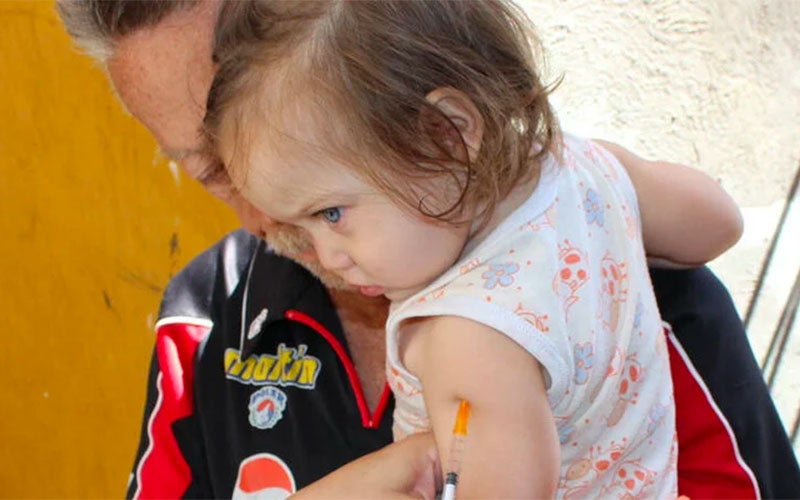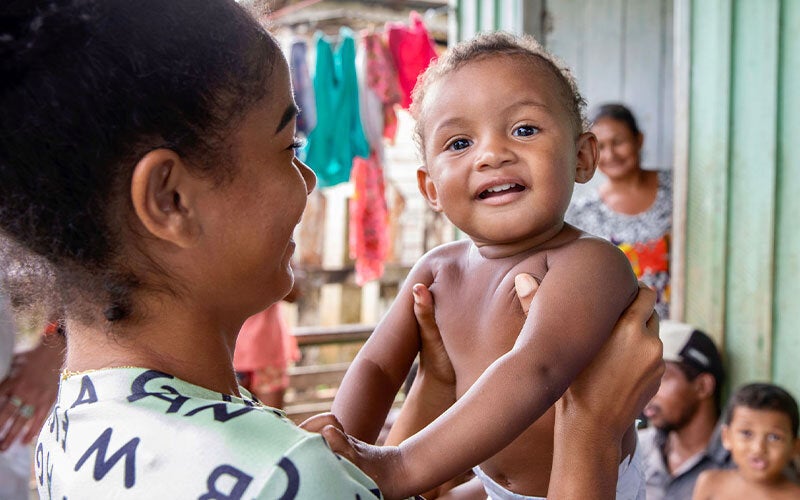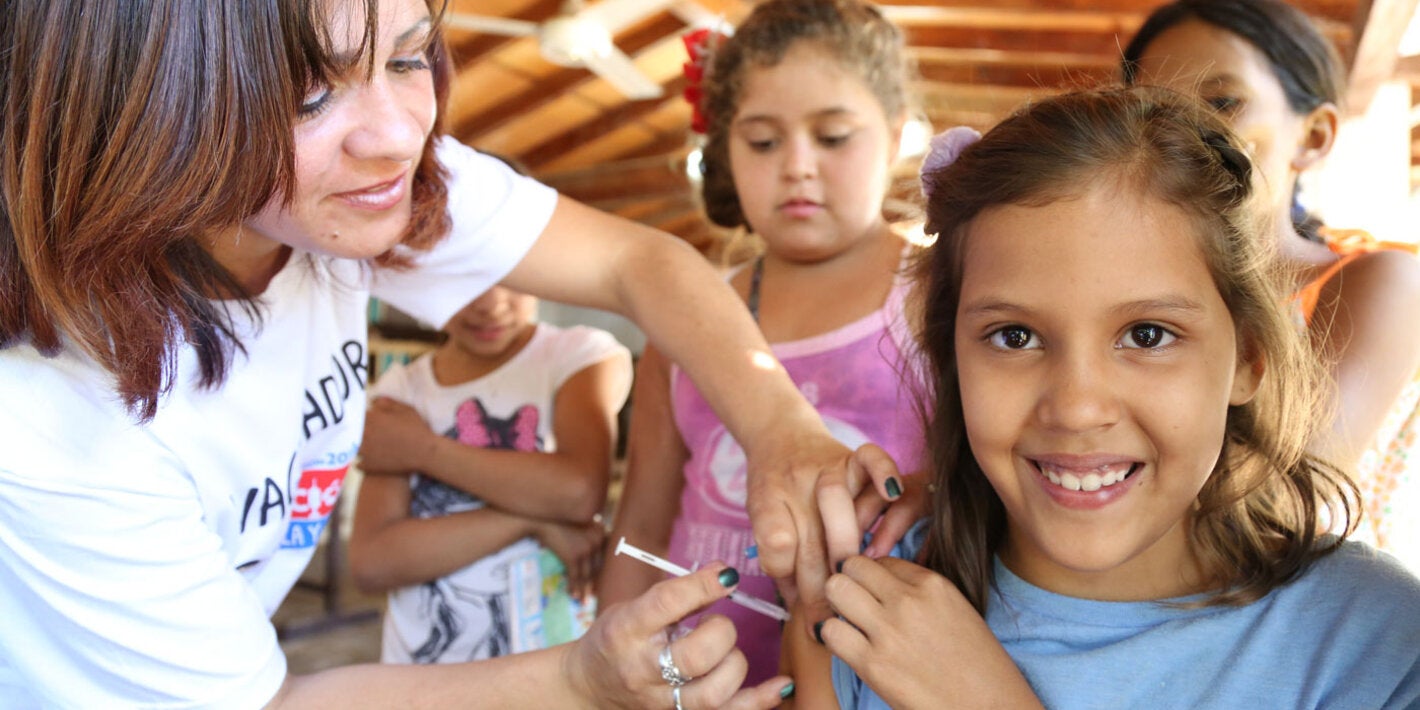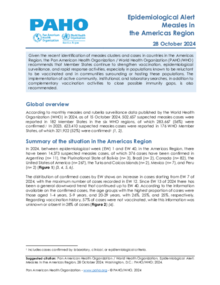Measles is a highly contagious viral disease, which affects mostly children. It is transmitted via droplets from the nose, mouth, or throat of infected persons. Initial symptoms, which usually appear 10-12 days after infection, include high fever, runny nose, bloodshot eyes, and tiny white spots on the inside of the mouth. Several days later, a rash develops, starting on the face and upper neck and gradually spreading downwards. There is no specific treatment for measles and most people recover within 2-3 weeks. However, particularly in malnourished children and people with reduced immunity, measles can cause serious complications, including blindness, encephalitis, severe diarrhea, ear infection, and pneumonia. Measles can be prevented by immunization.
- Measles is a very contagious viral disease that especially affects children and can cause severe health problems, including severe diarrhea, ear infections, blindness, pneumonia, and encephalitis (swelling of the brain). Some of these complications can lead to death.
- At the global level, measles continues to be one of the leading causes of death among young children, despite the fact that there is a safe and effective vaccine to prevent it. There is no specific antiviral treatment against the measles virus.
- Serious cases are especially frequent in malnourished young children, especially those whose immune systems are weakened. In populations with high levels of malnutrition and inadequate health care, measles can kill in up to 10% of cases.
- Measles is transmitted by airborne droplets from the nose, mouth, or throat of an infected person. The virus can stay active and contagious in the air or on surfaces for two hours.
- Symptoms tend to be high fever, runny nose, cough, red and watery eyes, small white spots on the inside of the cheeks, and widespread rash all over the body.
- Before widespread vaccination began in 1980, measles caused 2.6 million deaths a year throughout the world, 12,000 of them in the Americas.
- Between 1970 and 1979, Latin American countries reported about 220,000 cases of measles a year.
Measles is the fifth disease to be eliminated from the Americas, following smallpox (1971), polio (1994), and rubella and congenital rubella syndrome (2015). In all five cases, the Region was the first in the world to achieve elimination. Most PAHO/WHO member countries introduced the triple viral vaccine (MMR) against measles, mumps, and rubella between 1980 and the early 2000s.
In 1994, the countries collectively set the goal of eliminating endemic transmission of measles by 2000, through the implementation of PAHO-recommended surveillance and immunization strategies. By 2002, endemic transmission had ended in the Americas, but a decision to wait on certification was made so measles and rubella elimination could be jointly declared. A measles outbreak in 2013-2015 delayed this process. Rubella was certified as eliminated in 2015. The last case of endemic measles in the Americas in the post-elimination era was reported in July 2015 in Brazil.
A dose of the vaccine to prevent measles, mumps, and rubella (MMR) costs $1.14, when purchased through the PAHO Revolving Fund (in 5-dose vials). WHO estimates that measles vaccination prevented 17.1 million deaths worldwide between 2000 and 2014 a decrease of 79%. Measles continues to circulate in other regions of the world, and countries in the Americas report sporadic imported cases.
To maintain measles elimination, PAHO/WHO and the International Expert Committee for Measles and Rubella Elimination recommend that all countries in the Americas to:
- Maintain high vaccination coverage equal to or greater than 95%, with two doses of measles, rubella and mumps vaccine.
- Strengthen surveillance systems for febrile eruptive disease, i.e., people with fever and skin rash or rash, allowing early identification of cases coming from countries where the disease exists.
- Respond rapidly to cases identified through surveillance, vaccination campaigns and active search for other cases.
In 2010, the World Health Assembly established 3 milestones towards the future eradication of measles to be achieved by 2015:
- increase routine coverage with the first dose of measles-containing vaccine (MCV1) by more than 90% nationally and more than 80% in every district;
- reduce and maintain annual measles incidence to less than 5 cases per million;
- reduce estimated measles mortality by more than 95% from the 2000 estimate; and
In 2012, the Health Assembly endorsed the Global Vaccine Action Plan, with the objective of eliminating measles in four WHO regions by 2015 and in five regions by 2020.
By 2016, the global push to improve vaccine coverage resulted in an 84% reduction in deaths. During 2000-2016, with support from the Measles & Rubella Initiative and Gavi, the Vaccine Alliance, measles vaccination prevented an estimated 20.4 million deaths. During 2016, about 119 million children were vaccinated against measles during mass vaccination campaigns in 31 countries. All WHO Regions have now established goals to eliminate this preventable disease by or before 2020.









































